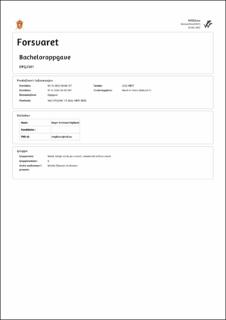| dc.description.abstract | The thesis is based on a naval study of a small, unmanned surface vessel. Furthermore, the study
has been conducted in accordance with the Norwegian method of procurement PRINSIX. The
study has been a preliminary project and involves the three first phases of the PRINSIX method:
The idea phase (IP), the concept phase (CP), and the definition phase (DP).
The IP analysed three ideas of conceptual solution: Mine Counter Measurement (MCM), Intelligence
Surveillance and Reconnaissance (ISR), and Force Sustainment USV’s in light of operational
needs in a top-down approach. Eventually, the output of the idea phase was a recommendation
to further investigate the idea of ISR USV’s.
The CP analysed analysed the capabilities and mission need for chosen alternatives, and further
identified the capabilities for the conceptual solutions. The output of this analysis was four
potential options: Continuation of current assets, small, passive ISR USV’s in large numbers,
small active and passive ISR USV’s in limited numbers, and small active and passive ISR
USV’s in limited numbers with offensive capabilities. Furthermore, a trade-off analysis, risk
assessment, and rought technical considerations regarding hull and propulsion was made. Consequently,
the CP concludes with a recommendation to move forward with option 1, Small ISR
USV’s with a towable passive sonar in conjunction with deployable sonobuoys. Furthermore,
the CP recommends moving forward with a conventional hydrostatic displacement hull and a
hybrid propulsion configuration.
The DP started off with specifying the preliminary capabilities and requirements for the chosen
conceptual solution. Furthermore, a preliminary vessel was chosen as a reference vessel. The
chosen reference vessel was then subject of a trade-off analysis with respect to alternative solutions
for hull, propulsor, drivetrain, energy producers, and energy storage. The preliminary
design solution was then deducted through a parametric study based on the preliminary capabilities
and requirements, and the parameters in the design spiral. Moreover, a set of optimized
parameters and a final optimized solution was presented and further analysed with respect to a
weight breakdown, cost assessment, and a risk assessment. Finally, a recommendation was
made based on the findings in the points of decision and the associated risk analysis. In conclusion,
the recommendation is to not move forward into a development- and completion phase,
judging the current state of the vessel. Further optimization is essential to reduce the risk of
procurement. | en_US |



